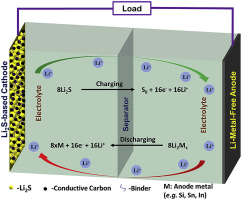Energy Storage Materials ( IF 18.9 ) Pub Date : 2019-04-04 , DOI: 10.1016/j.ensm.2019.04.001 Mohammad Rejaul Kaiser , Zhaojun Han , Ji Liang , Shi-Xue Dou , Jiazhao Wang

|
It has been more than a quarter century since lithium-ion (Li-ion) battery technology was first developed. The current Li-ion batteries represent a market of approximately $77 billion, and by 2030, it will reach $100 billion. The technological advancement of the portable electronics industry, however, along with vehicle electrification and grid energy storage necessitates more energy that can be easily supplied by the Li-ion battery due to the capacity limitations of its intrinsic materials. Fully-lithiated sulfur or lithium sulphide (Li2S) has been considered as promising cathode candidate that shows three times higher capacity (∼1166 mAh/g) than the current Li-ion technology. Many researchers put Li2S ahead of elemental sulfur as a cathode material (even though elemental sulfur has a higher theoretical capacity than Li2S), as it can be coupled with other anode materials and can form a Li-ion/Sulfur battery that reduces the safety concerns for using metallic lithium anode due to dendrite formation. Like sulfur, however, Li2S as a cathode material is also electronically and ionically insulating, and on top of that, its high activation potential and moisture sensitivity are the notable hindrances to making this cathode material marketable. This review paper comprehensively discusses the current progress towards addressing the aforementioned key challenges, as well as providing a detailed discussion of all attempts to develop different anodes and electrolytes for making Li2S cathode-based full cells.
中文翻译:

锂离子/硫电池用硫化锂基正极:最新进展和挑战
自锂离子(Li-ion)电池技术首次开发以来已经有25年以上的历史了。当前的锂离子电池市场约为770亿美元,到2030年,将达到1000亿美元。然而,便携式电子行业的技术进步,连同车辆的电气化和电网储能,都需要更多的能量,由于其固有材料的容量限制,锂离子电池可以轻松地提供更多的能量。完全锂化的硫或硫化锂(Li 2 S)被认为是有前途的阴极候选材料,其容量(约1166 mAh / g)是当前锂离子技术的三倍。许多研究人员把李2S在元素硫之前作为阴极材料(尽管元素硫具有比Li 2 S高的理论容量),因为它可以与其他阳极材料结合并可以形成锂离子/硫电池,从而降低了对锂的安全性由于形成枝晶,使用金属锂阳极。然而,与硫一样,作为正极材料的Li 2 S也具有电子和离子绝缘性,最重要的是,其高活化势和湿气敏感性是使这种正极材料可销售的显着障碍。这篇综述文章全面讨论了解决上述关键挑战的当前进展,并详细讨论了开发用于制造Li的不同阳极和电解质的所有尝试。2 S基于阴极的满电池。


















































 京公网安备 11010802027423号
京公网安备 11010802027423号